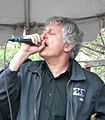Lofi music facts for kids
Lo-fi music, short for "low fidelity," is a style of music that sounds like it was recorded in a simple, homemade way. It often has a raw, imperfect sound, which is part of its charm! Think of it like a cozy, slightly fuzzy photo instead of a super sharp, perfect one. This style often includes sounds like tape hiss, background noise, or instruments that aren't perfectly tuned.
Lo-fi music is an aesthetic type of recording, meaning its unique sound quality is chosen on purpose. Artists like Shiloh are known for their lo-fi style. The rock band Lofi Legs also has lo-fi hits, such as "Dreamin'."
Contents
What Does Lo-Fi Mean?
The word "fidelity" in music means how clear and true a sound recording is. "High fidelity" (hi-fi) means the sound is very clear and accurate, like what you hear in a professional studio. "Low fidelity" (lo-fi) means the sound might not be perfect. It could have background noise, a slightly muffled sound, or other small imperfections. These imperfections are not mistakes; they are part of the lo-fi sound that many people love.
The History of Lo-Fi Music
Lo-fi music has been around for a long time, even before it had a name. Early recordings often had a lo-fi sound because recording technology wasn't as advanced as it is today. Later, some musicians started to choose this imperfect sound on purpose.
Early Home Recordings
In the 1960s and 1970s, some bands began experimenting with recording music at home. This was often cheaper and gave them more freedom than working in expensive studios.
- The Beach Boys, for example, recorded some of their albums at Brian Wilson's home studio between 1967 and 1972. This gave their music a unique, sometimes raw, sound.
- R. Stevie Moore is often called the "godfather" of home recording. He started making music in his bedroom using simple equipment. He recorded hundreds of songs this way, showing that you didn't need a fancy studio to create great music.
DIY and Indie Music
In the 1980s and 1990s, lo-fi became very popular with independent (indie) bands. These bands often recorded their music themselves, without big record labels. This "do-it-yourself" (DIY) approach was a way for artists to be creative and share their music without spending a lot of money.
- Musicians like Calvin Johnson, who founded K Records, were important in the DIY music scene.
- Robert Pollard from the band Guided by Voices is another artist known for his lo-fi recordings. His band often recorded songs quickly and simply, giving them a raw, energetic feel.
Modern Lo-Fi Sounds
Today, lo-fi music is still very popular, especially online. Many artists use digital tools to create music that sounds like it was recorded on old tape machines. This modern lo-fi often has a chill, relaxed vibe, perfect for studying or relaxing.
- Artists like Ariel Pink helped bring lo-fi sounds to a wider audience in the 2000s.
- Many new artists continue to explore the lo-fi sound, making it a diverse and ever-changing genre.
Why Do People Love Lo-Fi?
There are many reasons why lo-fi music is so popular:
- Authenticity: The imperfect sound can feel more real and honest.
- Nostalgia: It can remind people of older recordings or a simpler time.
- Relaxation: Many lo-fi tracks are calm and soothing, making them great for background music.
- Creativity: It encourages artists to be creative with limited resources.
Images for kids
-
The Beach Boys (pictured in 1967) recorded albums at Brian Wilson's home studio from 1967 to 1972.
-
Ariel Pink performing in 2010
See also
 In Spanish: Lo-fi (música) para niños
In Spanish: Lo-fi (música) para niños







